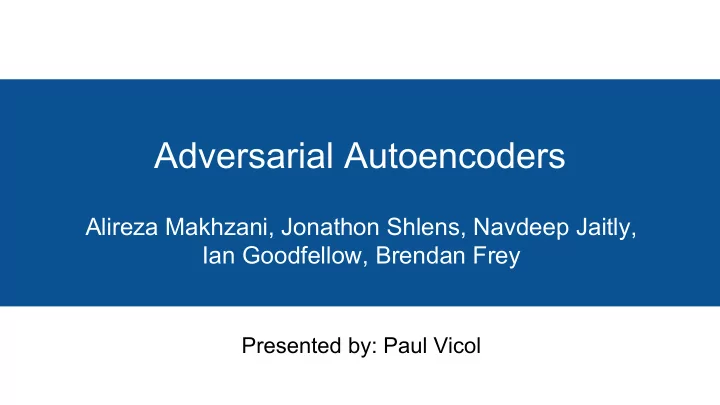

Adversarial Autoencoders Alireza Makhzani, Jonathon Shlens, Navdeep Jaitly, Ian Goodfellow, Brendan Frey Presented by: Paul Vicol
Outline Adversarial Autoencoders ● ○ AAE with continuous prior distributions ○ AAE with discrete prior distributions Every single part of the movie was absolutely great ! ○ AAE vs VAE ● Wasserstein Autoencoders ○ Generalization of Adversarial Autoencoders ○ Theoretical Justification for AAEs
Regularizing Autoencoders ● Classical unregularized autoencoders minimize a reconstruction loss ● This yields an unstructured latent space ○ Examples from the data distribution are mapped to codes scattered in the space ○ No constraint that similar inputs are mapped to nearby points in the latent space ○ We cannot sample codes to generate novel examples ● VAEs are one approach to regularizing the latent distribution
Adversarial Autoencoders - Motivation Goal: An approach to impose structure on the latent space of an autoencoder ● Every single part of the movie was absolutely great ! Idea: Train an autoencoder with an adversarial loss to match the distribution ● of the latent space to an arbitrary prior ○ Can use any prior that we can sample from either continuous ( Gaussian ) or discrete ( Categorical )
AAE Architecture ● Adversarial autoencoders are generative autoencoders that use adversarial training to impose an arbitrary prior on the latent code Encoder / GAN Generator Decoder - + Discriminator
Training an AAE - Phase 1 1. The reconstruction phase : Update the encoder and decoder to minimize reconstruction error Encoder / GAN Generator Decoder
Training an AAE - Phase 2 2. Regularization phase : Update discriminator to distinguish true prior samples from generated samples; update generator to fool the discriminator Encoder / GAN Generator - + Discriminator
AAE vs VAE ● VAEs use a KL divergence term to impose a prior on the latent space ● AAEs use adversarial training to match the latent distribution with the prior Reconstruction Error KL Regularizer Replaced by adversarial loss in AAE Why would we use an AAE instead of a VAE? ● ○ To backprop through the KL divergence we must have access to the functional form of the prior distribution p(z) ○ In an AAE, we just need to be able to sample from the prior to induce the latent distribution to match the prior
AAE vs VAE: Latent Space ● Imposing a Spherical 2D Gaussian prior on the latent space Gaps in the latent space; not well-packed AAE VAE
AAE vs VAE: Latent Space ● Imposing a mixture of 10 2D Gaussians prior on the latent space VAE emphasizes the modes of the distribution; has systematic differences from the prior AAE VAE
GAN for Discrete Latent Structure ● Core idea: Use a discriminator to check that a latent variable is discrete
GAN for Discrete Latent Structure Without GAN Regularization With GAN Regularization ● induces the softmax output to be highly peaked at one value ● Similar to continuous relaxation with temperature annealing, but does not require setting a temperature or annealing schedule
Semi-Supervised Adversarial Autoencoders ● Model for semi-supervised learning that exploits the generative description of the unlabeled data to improve classification performance ● Assume the data is generated as follows: ● Now the encoder predicts both the discrete class y (content) and the continuous code z (style) ● The decoder conditions on both the class label and style vector
Semi-Supervised Adversarial Autoencoders
Semi-Supervised Adversarial Autoencoders Imposes a discrete (categorical) distribution on the latent class variable Imposes a continuous (Gaussian) distribution on the latent style variable
Semi-Supervised Classification Results ● AAEs outperform VAEs
Unsupervised Clustering with AAEs ● An AAE can disentangle discrete class variables from continuous latent style variables without supervision ● The inference network predicts one-hot vector with K = num clusters
Adversarial Autoencoder Summary Pros ● Flexible approach to impose arbitrary distributions over the latent space ● Works with any distribution you can sample from, continuous and discrete ● Does not require temperature/annealing hyperparameters Cons ● May be challenging to train due to the GAN objective ● Not scalable to many latent variables → need a discriminator for each
Wasserstein Auto-Encoders (Oral, ICLR 2018) ● Generative models (VAEs & GANs) try to minimize discrepancy measures between the data distribution and the model distribution ● WAE minimizes a penalized form of the Wasserstein distance between the model distribution and the target distribution: Reconstruction cost Regularizer encourages the encoded distribution to match the prior
WAE - Justification for AAEs ● Theoretical justification for AAEs: ● When WAE = AAE ● AAEs minimize the 2-Wasserstein distance between and ● WAE generalizes AAE in two ways: 1. Can use any cost function in the input space 2. Can use any discrepancy measure in the latent space ● Not just an adversarial one
Thank you!
Recommend
More recommend